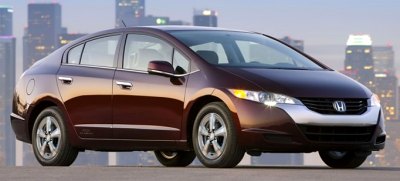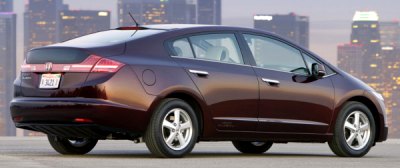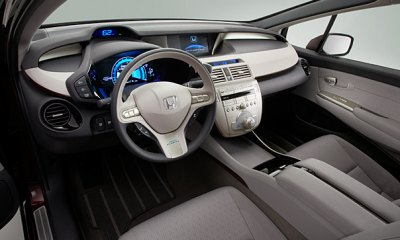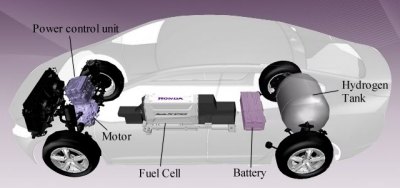|

|
Hydrogen fuel cell could be the
ultimate solution to our air pollution...
|
Being a Sc-Fi addict in my
teenage, I always dreamt of hydrogen cars. Think about it: by burning
hydrogen, you get the power you need, and the only by-product is pure
water. No nitrous gas, hydrocarbons or even carbon dioxide. It could be
the ultimate solution to our air pollution problem.
In reality, however, it is not as simple. In the 2 past decades,
various
car makers have been working hard on hydrogen technology. One camp, led
by BMW and Mazda, tried to realize hydrogen cars by adapting
conventional internal combustion engines to drink hydrogen fuel. This
resulted in the experimental BMW Hydrogen 7 and Mazda RX-8 Hydrogen RE.
They were more realistic for mass production, but they were also
hampered by
poor efficiency - hydrogen fuel has much lower energy density than
gasoline or diesel, so the same engine capacity produces much lower
power and torque than conventional engines do. Moreover, the
high-temperature combustion process generates nitrous gases (NOx)
besides water vapour, so internal combustion hydrogen engines are not
completely clean.
Another camp led by Mercedes and Honda concentrates on developing
hydrogen fuel cell. Fuel
cell uses a thin layer of Proton Exchange
Membrane (PEM) to generate electricity from the chemical reaction of
hydrogen and oxygen. Each hydrogen molecule is catalytically
dissociated into proton (positive hydrogen ion) and free electron. The
latter is absorbed by the anode electrode as useable electric current.
The photon migrates though the membrane layer to the other side and
reacts with the oxygen in airflow, resulting in pure water and heat.
Each fuel cell is therefore a chemical battery with a voltage
approximately 0.7V. By stacking hundreds of cells together, you get a
large generator to power your electric car. Fuel cell has an efficiency
of over 50%, double of internal combustion engines.

|
FCX looks as futuristic as its
technology...
|
Since
the late 1990s,
Mercedes-Benz has been experimenting fuel-cell cars in the name “NECAR”
and “F-Cell”. However, it was Honda that came first to market fuel-cell
cars to the public. In late 2007, Honda announced to produce 200 units
of FCX Clarity. They would be leased to interested customers in Japan
and USA for 3 years. While its production cost is still way too high
for commercialization - some estimate up to US$1 million each - FCX
Clarity can prove the technical feasibility of fuel cell technology in
real world.
At first glance, the FCX looks as futuristic as its technology, thanks
to a wedge and cab-forward shape. It’s almost the same size as an
American Honda Accord, just with a shorter front overhang. A set of
16-inch wheels look small these days, but perfectly reasonable for a
car having a 100 mph top speed. I am glad that its designers did not
pursue form over functions.
Inside, it is even more futuristic. The dashboard design is multilayer
and multi-tone, very inviting. A digital speedometer locates above the
main instrument pod and as close as possible to the windscreen, so it
doesn’t need HUD to keep your vision on the road. The main instrument
pod contains a color LCD dial with a fancy name, Powerball. It
indicates the status of fuel cell and battery output. Drive
economically and the Powerball will glow to green or blue. More
unforgiving and it will glow to yellow or red, reminding your
environmental guilt.
Although the FCX is an experimental car, its cabin is very well built
and trimmed. Bio-fabrics are used extensively throughout the cabin to
show its environmental conscious. All passengers enjoy abundance of
space as in the American Accord, but here the rear seat is strictly for
two because a tall central tunnel extends from the console halfway into
the rear passenger compartment. In fact, the central tunnel contains
the fuel cell.

|
The main instrument pod contains a
color LCD dial with a fancy name, Powerball.
|
Honda’s
new generation fuel cell is much lighter and smaller than the first
generation shown in 2005. It weighs only 67 kg and takes about the
space of a desktop computer. However, its associated cooling facility
is not small enough to be fitted between the front seats, so the FCX
has to sacrifice its middle rear seat. The vertically mounted fuel cell
takes advantage of gravity to help fuel drainage, reducing its size and
weight. Electric heating helps it to start running at as low as -30
degC. Compared with its 2005 predecessor, it is a big advancement.
The fuel cell can generate up to 100kW (136hp). This output is then
converted to AC in the power control unit and powers the
front-axle-mounted electric motor. As 189 lb-ft of torque is available
right from 0 rpm, the FCX feels quite brisk at take off. As its
transmission has only one forward gear and one reverse gear, the
acceleration is as linear as you can imagine. Its 0-60 mph time is
about 9 seconds, comparable to a conventional 2-liter family car. Top
speed is less impressive though, as the transmission is geared to 100
mph only.
As in any hybrid or electric cars, the FCX utilizes regenerative
braking to recharge its battery. This Lithium-ion battery is stored
under the rear seat so that it takes no extra space – unlike the bulky
hydrogen fuel tank that compromises the trunk. When the car comes to a
stop, the fuel cell is turned off immediately. Then all the electric
power consumption – air conditioning, lighting, control systems, cabin
equipments
etc. – will be fed by the battery. When the car starts accelerating,
the battery provides the initial push until the fuel cell gets back
into operation. The hydrogen fuel tank stores liquefied hydrogen at
5000 psi (345 bar). Honda claims 3.92 kg of hydrogen gives it a driving
range of 240 miles. Fuel consumption is measured by miles per kg.
Converting to EPA figures, you get 79 mpg in city and 68 mpg on
highway. Carbon-dioxide emission is… well, zero.
The
FCX employs Accord’s
suspensions, i.e. double wishbones up front and multi-link at the rear.
On the road, apart from a numb electric power steering and slightly
abrupt braking – both are common problems to electric and hybrid cars,
by the way – its handling and ride is similar to Accord. Despite of its
1630 kg weight, it is quite agile in corners, thanks to the key
components that locate low and near the center of its chassis.

|
You can see hydrogen fuel cell cars as
electric cars plus a series of unnecessary electrochemical conversion...
|
See the car in isolation, FCX Clarity is unquestionably very
impressive. It drives nearly as good as conventional cars in terms of
performance and handling. Its accommodation and driving range might be
a little down on existing standards, but still practical enough for
most people. No wonder Honda believes its fuel cell cars could enter
mass production in 10 years' time. However, in my opinion 3 hurdles
must be overcome first:
1. Price: until now fuel cells are still far more expensive than
electric or hybrid technology, let alone conventional engines.
2. Infrastructures for refueling: hydrogen production plants,
transportation system and refueling stations cost billions of dollars
to build even in a small country. Government policy support will be
essential. Without these infrastructures,
hydrogen fuel cell cars will never be popular. The FCX is currently leased to only customers
resident near experimental refueling stations built by Shell.
3. It is questionable whether hydrogen fuel cell technology is really
clean. The generation of hydrogen from water consumes a lot of
electricity, which is largely generated by fossil fuel until now. Of
course, we can build solar, wind or hydro power plants to generate
hydrogen, but it could be even more efficient using these plants to
supply household electricity needs instead of cars. Moreover, if
hydrogen cars are to go mass production, it will be doubtful whether we
can build as many renewable energy power plants to satisfy the demand.
Besides, there are question marks over the transportation and storage
efficiency of hydrogen fuel, as liquefied hydrogen gradually vapors and
is released back to atmosphere over time.
However, the biggest blow to FCX Clarity & Sons could come from
electric cars. From the development of this couple of years, we can see
electric cars have received the biggest push from car makers and
component suppliers. Their price and performance have been fast
improving. You can see hydrogen fuel cell cars as electric cars plus a
series of unnecessary electrochemical conversion. Instead of using the
electricity from power plants to drive your car directly, they convert
the electricity to hydrogen, transport to refueling stations, fill in
the car, then convert back to electricity through the PEM reaction to
power the car. Each step downgrades the power efficiency. It is no
brainer which one is more efficient. In terms of cost, I think battery
is also more hopeful than fuel cell to get to reasonable level for mass
application.
Because of the aforementioned reasons, I don't think hydrogen fuel cell
cars will ever succeed. However, it is undeniable that Honda has done a
great job to realize the FCX Clarity as an experimental car, and by the
way fulfilled my teenage dream. |